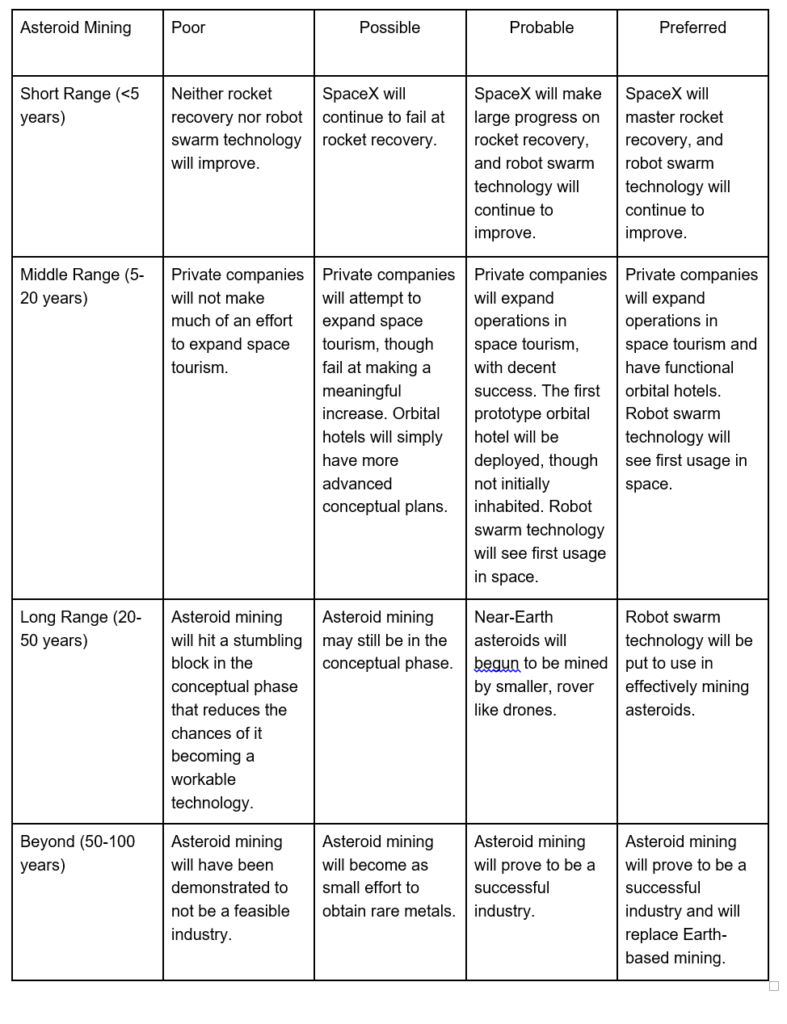The Qualitative Futures Square (QFS) is a method of formulating a futures hypothesis. Like a general scientific hypothesis, a futures hypothesis is a starting point in investigating a futures possibility. The QFS is a flexible tool, capable of being the first stepping stone in analyzing futures for industries, technologies, and events. As a tool for formulating hypotheses, it is appropriate that the input for the squares are guesses. This is simply a tool for orderly stating what you believe will happen.
The axes of a QFS are order (Poor, Possible, Probable, and Preferred) and Timeline (Short Range, Middle Range, and Long Range). As bias is impossible to remove entirely from futures studies, Preferred is filled first for order, but comes last. Preferred allows the futurist to clearly state what they wish to happen. This allows the futurist to separate out their emotional bias and allows the reader to watch for wishful thinking. Probable is filled next, as this allows the futurist to clearly state their belief as to what will happen. This is another form of bias, the logical bias. While this seems like an odd bias, different futurists (and people in general) have different patterns in their thinking, allowing two people to state two different outcomes as the likely outcome from the same event. Next filled out is Possible, which allows the futurist to state what may happen, after removing what they want to happen and what they believe will happen. Poor is filled out last, and comes first, as it demonstrates the outcome the futurist wishes to avoid. Input from the Poor and Preferred boxes should at least partially overlap input in either the Probable or Possible boxes. The Timeline definitions are actually flexible, though the ranges given are the most commonly useful. Even when using the standard <5, 5-20, 20-50, and 50-100 year ranges, it is still best to label the ranges you use. As a general rule of thumb, there should be a clear gradient of specificity from short term to beyond, with beyond making general speculations. There is a fine line between being general and being vague, and you should always guard against being unnecessarily vague.
Latchkey issues: Legislation is a key issue for asteroid mining. As profitable of an enterprise as it is capable of being, the likelihood is diminishingly small that a company will seek to begin asteroid mining without legislative support. Investment levels are also crucial for asteroid mining. Both research & development and execution are going to be incredibly costly for asteroid mining, and the likelihood is low that governments will be willing to put forth that initial investment for some time.
Synergies: Robotic swarm technology is crucial for further down the road, and important progress must be made now. Asteroid mining can’t be undertaken utilizing standard methods of mining on Earth, and robotic swarms present the most efficient way to mine asteroids. However, there are other possible methods, and so robotic swarm technology isn’t quite a latchkey issue. Both space tourism and space hotels are heavily synergistic in a financial sense with asteroid mining. Space tourism and hotels can drive the heavy interest in space that will be necessary to handle the latchkey issue of investment. In turn, if/when asteroid mining is a standardized practice, it will further legitimize space-based enterprises, making investment into space tourism/hotel startups more appetizing for investors.
Key players: SpaceX is currently leading the charge for privatized space exploration. As such, it is likely that they will continue to do so. The United States is currently the only nation in the world with legislation authorizing space mining, and as such is likely to be host to whatever company decides to pursue asteroid mining. Planetary Resources is the company perhaps most likely to begin asteroid mining first, with plans to begin with near-Earth asteroids within the next decade or two. The robotics industry as a whole will play a key part with swarm robotics, though there will need to be (at least) one company specializing in the design of asteroid mining robotics, as the physics is drastically different.
Wildcards: The main possible wildcard is a government agency obtaining the funding to aggressively pursue asteroid mining. The likelihood for this is rather low (I estimate ~7%), but not so small as to ignore. Aggressive government pursuit would likely take the form of establishing the foundation for private industry to thrive from, and would radically speed up the above time schedule and lean outcomes toward Preferred.




Leave a Reply